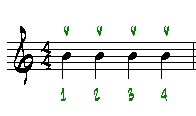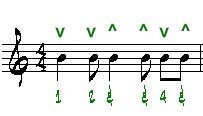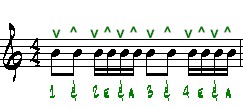Scroll through the lesson and click on notation/video/audio links to load the interactive players.
| Lyle Ronglien >> Guitar Essentials >> |
|
|
Please subscribe to get full access to all lessons for only $7.95/month PLUS 1 week free trial.

Riff Interactive lessons are
LESS expensive and
MORE interactive than alternatives!
More Info
|
|

Guitar
Essentials
Lesson 2 - Rhythm
Lyle:
During this series of lessons I want to teach you many different essentials to
becoming a better guitar player.
Lyle: This lesson is all about counting out loud,
tapping your foot, and strumming or picking your guitar.
Lyle: Check out this first rhythm, based on just
quarter notes:
rhythm 1

Lyle: You should learn how to tap your foot and
count out loud at the same time.
Lyle: Try this:
Lyle:
Your goal is to be able to tap your foot, count out loud, and pick a note all at
the same time.
Lyle: Sounds easy? Well. from my experience as a
teacher, there are many students that struggle with this.
Lyle:
Here are a couple looping metronome beats you should practice all the upcoming
exercises with:
Lyle:
Let's try another rhythm:
rhythm 2

Lyle: V
= down stroke or strum, ^ = up
Lyle: This rhythm is harder to tap, count, and
play all at the same time. You have to sync up everything and feel the
rhythms.
Lyle: The video clips should provide a little
extra help.
Lyle: Let's try a new
rhythm:
rhythm
3

Lyle: Here's rhythm 3:
dh: If we were
to play rhythm 3 with the metronome set at 90 would that be 90 beats for each
down stroke? And the upstroke would be between the metronome
beats?
Lyle: dh, yes.
Lyle: rhythm 3 is
all 8th notes.
Lyle: Don't tap your foot 8 times per measure,
just on the "down" beats.
Lyle: The down beats are the 1, 2, 3,
4.
Lyle:
the "and's" are the up beats.
Lyle: Try this next one:
rhythm
4

Lyle:
Next is a popular rhythm for strumming. The 1 beat gets an accent, followed by
8th notes.
rhythm
5

Lyle:
Next rhythm is another very popular strumming rhythm, yet it is hard to play for
many of my beginner students.
rhythm 6

walker: Lyle is
it possible for you to do a bo diddley rhythm example?
Lyle:
sure
dh: Lyle is
there an 1/8 note "rest" on count 3 rhythm 6?
Lyle:
dh, that's not a rest, you let it ring.
dh: Okay
Lyle: The next rhythm is all 16th
notes:
rhythm
7

zz: how do you
practice these rhythms? last lesson you gave us a kind of warm up plan for
each?
walker:
not to hang up your lesson, but doesn't the bo diddley rhythm have to change in
order to sound good? in other words isn't there a lot of muting and accenting,
while keeping the beat but doing it in different ways?? I guess this is more of
a lesson question
Lyle: ZZ, you want to learn how to tap your foot,
count out loud, and pick or strum a note or chord for each of these
rhythms.
Lyle: walker, that's the basics of the diddly
rhythm. Sure you can put scratch mutes and stuff in-between those
rhythms.
walker:
thx
rhythm
8

mlnjr: I just ran run a couple o' scales - and they
seemed to 'flow' allot better with the one-e-and-a going thru my
head.
Lyle:
good!
Lyle: The next rhythm is 8th note triplets. 3
beats for each quarter beat.
rhythm 9

Lyle:
Next is a variation of the 8th note triplets. This is also known as the shuffle
beat, used in blues rhythms:
rhythm 10

Lyle:
The video clip helps explain this rhythm:
Lyle:
There are other cool rhythms to learn but these are the basic ones. Being able
to tap your foot, count out loud, and pick or strum any of these rhythms is very
important in your overall study of music and the guitar.
|
<< load notation from left
|
|
<< load audio from left
|
<< load audio from left
|